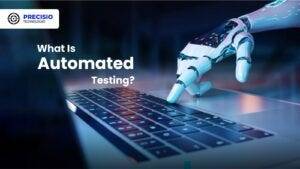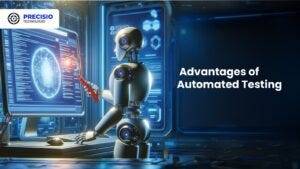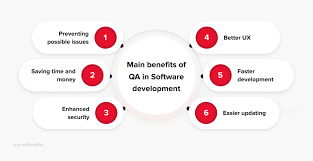#exploratory testing in agile
Explore tagged Tumblr posts
Text

Exploratory Testing In Agile Blog By Edu-Art
In this Blog, we will explore the benefits of utilizing exploratory testing in an agile environment and how it helps unlock the true potential of software quality assurance. We’ll explore the reasons why agile teams are embracing this approach and how it complements their fast-paced and iterative development cycles.
#exploratory testing in agile#exploratory testing#studying#success#teaching#institute#software#software testing#software testing course in thane#course
0 notes
Text
Automated Testing vs. Manual Testing: Which One is Right for Your Project?

Achieving high-quality, reliable software stands as a fundamental requirement in software development. Successful testing functions as an essential tool to discover faults and build performance capabilities that create better user experience outcomes. Two main testing methods dominate the field: automated testing and manual testing. The process of quality software assurance uses different testing approaches that demonstrate their own advantages as well as weaknesses according to specific project requirements and scenarios. We will explore the specifics to determine which testing process works best for your system development efforts.
1. What Is Manual Testing?

Manual testing involves a human tester manually executing test cases without using automation tools. Key Characteristics:
The methodology focuses its efforts on user interface together with usability and experience testing.
Human-centered applications where selection requires discretion include ad hoc testing and enumerative testing as well as examinations that need human evaluation.
Human performers are required during this approach; thus, it demands substantial time.
2. What Is Automated Testing?

Software performing automated testing executes test cases through workflows and helpers. Key Characteristics:
Efficient for repetitive and regression testing.
Users must spend money on tools along with developing custom scripts for testing.
Reduces human error.
3. Advantages of Manual Testing

Human Intuition: Software testing professionals can detect kernels through their human cognitive ability that automated tools cannot match. The observation and evaluation of visual elements runs more efficiently through human operatives instead of advanced tools.
Flexibility: This method suits exploratory testing specifically because there are no pre-determined scripts available.
Low Initial Investment: Running this approach does not need tool purchases or applications to develop automation frameworks.
Adaptable for UI/UX Testing: Running this approach does not need tool purchases or applications to develop automation frameworks.
4. Advantages of Automated Testing

Speed: Executes repetitive tests much faster than humans.
Scalability: The system proves most effective for extensive projects that need constant system updates.
Accuracy: When performing recurring actions, automated systems minimize the chances of human mistakes.
Cost-Efficient in the Long Run: Once established and implemented, the system demands costly investments but ensures continuous development expenses decrease over time.
Better for CI/CD Pipelines: Such testing technology connects various development pipelines that support agile and DevOps methodologies.
5. Disadvantages of Manual Testing

Time-Consuming: The manual performance of repeated tests leads to delayed completion of projects.
Error-Prone: Large applications contain tiny bugs that human testers commonly fail to detect.
Not Ideal for Scalability: The process of increasing manual testing needs additional testers to avoid cost escalations.
6. Disadvantages of Automated Testing

Initial Costs: Organizations must provide high financial resources to procure testing tools together with developing programming constructs.
Limited to Pre-Defined Scenarios: These testing approaches work poorly for handling exploratory or ad hoc testing.
Requires Maintenance: Test scripts need frequent updates when application changes occur.
Not Suitable for UI/UX Testing: Struggles with subjective user experience evaluations.
7. When to Use Manual Testing

Small Projects: The testing method proves beneficial at a low cost for small applications and provides quick assessments.
Exploratory Testing: Testing this approach benefits projects whose scripts have not been defined yet or need evaluation for newly added features.
Visual and Usability Testing: Performing assessments on interface components together with design features.
8. When to Use Automated Testing

Large Projects: Handles scalability for projects with frequent updates.
Regression Testing: Program testing becomes more efficient through automation since automated assessments perform multiple tests following each update process.
Performance Testing: The system performs efficient capabilities to conduct load testing and stress testing.
Continuous Development Environments: Agile progression and DevOps implementations need automation as a core requirement.
READ MORE- https://www.precisio.tech/automated-testing-vs-manual-testing-which-one-is-right-for-your-project/
2 notes
·
View notes
Text
Boost Business Agility with DevOps Consulting and Azure DevOps Services.
In today’s competitive digital world, companies need to deliver high-quality software quickly and reliably, with minimal risk. At CloudKodeForm Technologies, our DevOps consulting aims to bring development and operations closer together. We streamline your delivery process and support your digital growth.

Why DevOps is Important DevOps is more than a popular term. It’s a way to change how teams work by uniting development and operations with shared goals. Using automation, integrated tools, and flexible practices, businesses can speed up software releases. They also get better system stability and performance.
CloudKodeForm Technologies provides DevOps management services that help fix common development delays. From planning and building to testing and deploying, our team makes sure each part of your software cycle is fast and scalable.
Our Full DevOps Consulting Services Our services look at your current setup, find gaps, and help you build a plan. Whether you are new to DevOps or trying to improve what you have, our experts offer:
Infrastructure as Code (IaC) setups
Automation of CI/CD pipelines
Container tools and management (Docker, Kubernetes)
Security measures integrated into workflows (DevSecOps)
Ongoing performance checks to improve results
We focus on aligning your tools, teams, and processes so you can deliver software smoothly and continuously.
DevOps Management: From Start to Finish Once your plan is ready, your next step is flawless execution. We support you with ongoing monitoring, support, and infrastructure management. Our team helps you:
Expand your system easily
Keep applications running smoothly
Manage cloud-based software
Follow rules and security standards
Our hands-on approach keeps your system safe and working well, reducing downtime and security risks. Your users will have a better experience too.
Making Your Delivery Faster The core of DevOps is the delivery pipeline. It automates everything from writing code to launching new features. This speeds up releases and cuts down mistakes.
At CloudKodeForm, we create pipelines for:
Continuous Integration (CI)
Continuous Delivery (CD)
Automated tests and quality checks
Deployment options like canary or blue-green releases
With a strong pipeline, you can push new features faster, respond quickly to market needs, and stay ahead of competitors.
Azure DevOps Setup: Easy Cloud Connection We also focus on Azure DevOps, giving you smooth connection to Microsoft’s cloud. From planning and coding to testing and releasing, Azure DevOps covers every stage.
Using Azure DevOps Services Sign In, your team can:
Work together with Git and project boards
Automate builds and releases with Azure Pipelines
Manage deployments with clear dashboards
Store and access project files securely
We help you set up and manage your Azure DevOps account fast, so everything stays secure and organized.
Azure DevOps Test Plans for Better Quality Quality matters in today’s software work. Azure DevOps Test Plans let us check your apps before they go live.
Our testing services include:
Manual and exploratory testing
Managing test cases and execution
Linking with CI/CD systems
Real-time reports and results
Using Azure DevOps Test Plans helps reduce bugs and improve app speed. It supports happier users and better performance.
0 notes
Text
The QA Starter Kit: A Comprehensive Manual Testing Guide

Quality assurance (QA) plays a critical role in the software development lifecycle. For any digital product to succeed in today's competitive landscape, rigorous testing is a must. While automation is gaining momentum, manual testing remains a foundational pillar of QA. This Manual Testing Guide offers a comprehensive understanding of manual testing—its processes, benefits, tools, and relevance in modern development environments.
What is Manual Testing?
Manual testing is the process of manually checking software for defects without using automated tools. Testers simulate end-user behavior to validate the application’s functionality, UI, and overall experience. Unlike automation testing, which requires scripts and frameworks, manual testing is based on human observation and logical reasoning.
This Manual Testing Guide is crucial for beginners and professionals looking to solidify their QA skills. It helps testers detect issues that automation might miss—like design inconsistencies, user experience flaws, and unexpected system behavior.
Importance of Manual Testing in the SDLC
Manual testing plays a pivotal role in each phase of the Software Development Life Cycle (SDLC). During the requirement phase, test scenarios are designed to align with user expectations. In the development phase, testers verify the UI and functionality. Before deployment, the QA team ensures the application meets quality benchmarks.
Understanding What is SDLC? Process, Phases, and Importance helps testers integrate manual testing efficiently within each development phase. This ensures that the end product is not only functional but also user-friendly and reliable.
Whether it’s a mobile app, desktop software, or enterprise platform, every product benefits from a thorough Manual Testing Guide that ensures high-quality output.
Types of Manual Testing
There are several types of manual testing, each with its own objective:
Smoke Testing – Verifies basic functionality.
Sanity Testing – Confirms that bugs have been fixed.
Regression Testing – Ensures recent changes haven't disrupted existing features.
Usability Testing – Evaluates user-friendliness.
Exploratory Testing – Involves creative test execution without pre-defined scripts.
A detailed Manual Testing Guide often includes sample checklists and scenario templates for each type, enabling testers to ensure full coverage of possible issues.
Manual Testing vs. Automated Testing
While automation accelerates the testing process and is ideal for repetitive tasks, manual testing remains critical for scenarios that require human insight. Usability, accessibility, and visual consistency are difficult to test using scripts alone.
If your product is in its early stages, and requirements keep evolving, manual testing offers the flexibility needed to adapt quickly. A strategic balance between manual and automation testing is ideal, and this Manual Testing Guide helps you identify which tests to automate and which to do manually.
Offshore Development and Manual Testing
When working with offshore teams, integrating manual testing into Agile workflows can be challenging but rewarding. The Manual Testing Guide becomes even more essential when scaling across global teams with varying QA standards.
A key resource in this scenario is How to Scale Agile in Offshore Software Development?, which outlines how to align QA goals, ensure continuous communication, and maintain consistent testing quality across borders. Manual testing ensures real-time validation and facilitates instant feedback loops in distributed Agile teams.
Tools Used in Manual Testing
Although manual testing doesn’t rely on automation scripts, several tools assist in the process:
Jira – For bug tracking and project management.
TestLink – Test case management.
Bugzilla – For defect tracking.
Trello – For organizing test workflows.
Including these tools in your Manual Testing Guide helps standardize your testing processes, improve collaboration, and enhance documentation across your QA team.
Book an appointment with our QA specialists today to evaluate your current testing setup and learn how manual testing can elevate your software’s quality and performance.
Role of Manual Testing in Software Application Development
In the realm of Software Application Development Services, manual testing validates each function against client requirements. It plays a crucial role in ensuring that software is user-friendly, bug-free, and aligned with business goals.
This Manual Testing Guide helps development teams identify potential bottlenecks, plan better release cycles, and reduce the cost of fixing post-deployment bugs. Manual testing allows teams to conduct real-time validations, especially for niche or client-specific scenarios where automation falls short.
Manual Testing for Web Applications
A web application development company thrives on delivering products that are both functional and seamless in performance. Manual testing enables QA teams to evaluate the behavior of web apps across different browsers, devices, and network conditions.
With this Manual Testing Guide, testers can perform accessibility checks, cross-browser testing, and responsive design validation—ensuring that users get the same experience across platforms. Manual testing also helps verify integrations with third-party services, ensuring the reliability of all interconnected features.
Final Thoughts
Manual testing remains an indispensable aspect of modern QA practices. While automation brings speed, manual testing brings depth and a human perspective. From identifying subtle UI issues to ensuring an intuitive user experience, manual testing fills the gaps that automated testing often overlooks.
This Manual Testing Guide is your go-to resource for mastering the core principles, processes, and tools essential for quality assurance. Whether you're part of a startup or an enterprise-level web application development company, implementing manual testing effectively ensures a robust, user-centric product.
By combining this guide with knowledge from related fields such as What is SDLC? Process, Phases, and Importance and Software Application Development Services, you can create a testing strategy that is both comprehensive and future-ready.
0 notes
Text
Self-Healing Test Automation: The Future of Reliable Testing with ideyaLabs

Revolutionize Your Quality Assurance with Self-Healing Test Automation Self-Healing Test Automation stands at the forefront of the software development lifecycle. ideyaLabs brings this transformative approach to organizations that demand efficiency, agility, and reliability. Automated tests often falter when changes occur in the codebase. This evolution often slows down deployment and increases maintenance workloads. Self-Healing Test Automation resolves these challenges.
What is Self-Healing Test Automation? Self-Healing Test Automation uses advanced algorithms to detect and fix test script failures automatically. The system identifies changes in the user interface or back-end structure. Whenever tests fail due to altered elements, the self-healing engine analyzes patterns, locates the new elements, and updates the scripts in real time. Testing teams monitor and validate without manual interference.
How ideyaLabs Implements Self-Healing Test Automation ideyaLabs tailors self-healing solutions to address unique business needs. Automation frameworks integrate seamlessly with existing tools. Machine learning components track the behavior of test scripts. Automated systems ensure that test cases dynamically adjust when updates in application interfaces occur. Teams enjoy uninterrupted test execution cycles. Projects stay on schedule and defects come under control.
Benefits of Self-Healing Test Automation with ideyaLabs Organizations achieve significant time savings. Maintenance costs drop as test scripts self-correct without human intervention. Automation frameworks remain robust, even during rapid software releases. Teams focus on valuable exploratory testing. Reliable tests accelerate go-to-market strategies. ideyaLabs clients boost product quality and operational velocity.
Eliminate Manual Test Maintenance Manual intervention often derails productivity. Self-Healing Test Automation eradicates mundane and repetitive test maintenance tasks. ideyaLabs empowers teams to shift attention toward innovative work. Engineers concentrate on developing new features, while the self-healing engine manages test scripts.
Continuous Integration with Zero Downtime Seamless integration with CI/CD pipelines marks a key strength of Self-Healing Test Automation. ideyaLabs optimizes pipelines by automating script updates during every build and deployment. Software updates no longer break automated tests. Teams receive instant feedback on application stability.
Machine Learning Enhances Self-Healing Accuracy Machine learning principles drive the efficiency of self-healing test scripts. ideyaLabs equips frameworks with smart algorithms. Systems recognize element locators, assess historical changes, and intelligently predict likely replacements. This elevated accuracy delivers resilience in the face of UI or code updates.
Accelerate Digital Transformation Businesses shift to digital-first approaches. Rapid updates remain vital in today’s marketplaces. Self-Healing Test Automation allows organizations to innovate faster. ideyaLabs ensures software releases meet the highest quality standards, supporting agile and DevOps methodologies.
Reduced Risk in Production Releases Poorly maintained test scripts result in hidden bugs and failed deployments. Self-Healing Test Automation eliminates such risks. ideyaLabs delivers proactive identification and correction of test script issues. Releases progress smoothly. Operational confidence increases across engineering teams.
Scalability for Enterprise Applications Large enterprise applications feature complex UIs and frequent changes. ideyaLabs deploys scalable self-healing automation frameworks to handle vast test suites. Test maintenance remains minimal, regardless of application size or complexity. QA departments experience less friction during expansion.
Elevate Collaboration Across Teams Test automation becomes more approachable and efficient with self-healing capabilities. ideyaLabs fosters cross-functional collaboration between testers, developers, and business users. Teams access real-time dashboards with test outcomes. Responsibility for quality becomes a shared objective.
Security and Compliance Prioritized Automated adaptation of test scripts preserves test coverage for critical functionalities. ideyaLabs frameworks comply with rigorous security and industry standards. Sensitive data remains protected during testing cycles. Compliance audits receive comprehensive evidence.
Faster Feedback Loops Drive Continuous Improvement Feedback speed drives rapid improvement. ideyaLabs speeds up reporting cycles with real-time detection and healing of test failures. Developers receive faster insights. Corrections occur sooner in the development stream.
Enhanced ROI from QA Investments Investment in QA yields greater returns with self-healing technology. ideyaLabs clients notice measurable improvements in delivery speed, reliability, and cost savings. Automated processes reduce overhead for maintenance. Business leaders realize faster payback periods.
Self-Healing Test Automation: A Must for Modern Organizations Organizations demand predictable outputs and high software quality. Self-Healing Test Automation addresses these needs. ideyaLabs provides cutting-edge services and solutions tailored to modern development challenges.
How to Start with ideyaLabs Self-Healing Test Automation Initiating a project requires collaborative assessment and planning. ideyaLabs experts consult with stakeholders to understand project requirements. Teams receive walkthroughs on integration with current frameworks. The implementation phase unfolds with minimal disruption. Support covers every step.
Case Studies Highlight Success Stories ideyaLabs has spearheaded automation success for clients in finance, healthcare, retail, and technology. Self-healing frameworks reduced test maintenance by up to 85% in diverse projects. Clients report on improved system reliability and faster deployment cycles.
Preparing for the Future of Testing Trends continue to shift. ideyaLabs positions clients at the forefront of innovation. Self-Healing Test Automation stands as the bedrock for future-ready QA processes. Automation adapts, learns, and evolves with each release.
Partner with ideyaLabs for Test Automation Excellence Choose ideyaLabs for seamless, sustainable, and scalable test automation. Experience superior quality assurance with minimal maintenance effort. Contact ideyaLabs today to transform your testing approach with Self-Healing Test Automation.
0 notes
Text
What is a QA Software Testing Course, and Why is it Important in Today’s Tech Industry?

Introduction
Imagine launching a new app, only to find users abandoning it due to bugs and glitches. In the fast-paced tech world, such failures can cost companies millions. That’s where QA (Quality Assurance) software testing comes in. A QA software testing course teaches learners how to ensure digital products function smoothly, meet customer expectations, and maintain brand credibility. Today, businesses can't afford to release faulty products. The demand for skilled QA professionals is growing across sectors. Quality assurance testing courses are designed to equip learners with practical skills to meet this demand. Whether you're new to tech or switching careers, enrolling in a QA Testing Online Training Course can open doors to a stable and high-paying job in the IT industry.
What is a QA Software Testing Course?
A QA software testing course is a structured program that trains individuals to test software applications to ensure they are bug-free, functional, and meet user requirements. It typically includes both manual and automated testing techniques.
Key Concepts Covered
Software Development Life Cycle (SDLC)
Software Testing Life Cycle (STLC)
Manual Testing Basics
Automation Testing (using tools like Selenium, QTP)
Defect Tracking and Reporting
Agile and DevOps Methodologies
Test Planning and Documentation
Why is QA Testing Important in the Tech Industry?
1. Quality Control Saves Money
According to the Consortium for IT Software Quality, poor software quality costs the U.S. economy over $2 trillion annually. QA testers prevent such losses by identifying issues early.
2. User Experience Matters
A broken app leads to bad reviews and customer loss. QA testing ensures a seamless user experience.
3. Security Compliance
Many industries like healthcare and finance require thorough testing to comply with regulatory standards. QA testers are crucial in ensuring this.
4. Faster Time-to-Market
Automated QA processes allow developers to release updates quickly without sacrificing quality.
What You Will Learn in a QA Testing Online Training Course
1. Manual Testing Techniques
Learn to write and execute test cases, report bugs, and perform usability testing.
2. Automation Testing Tools
Master tools like Selenium, JUnit, TestNG, and Jenkins. Real-world use cases include writing test scripts and running automated regression tests.
3. Test Management Tools
Explore tools like JIRA, Bugzilla, and TestRail for project and defect tracking.
4. Agile and Scrum Frameworks
Work in sprints, participate in stand-ups, and collaborate in cross-functional teams.
5. Live Projects
Get hands-on experience with real-world scenarios, helping you build a solid portfolio.
Real-World Applications of QA Testing Skills
Software Development Companies
Tech firms rely heavily on QA testers to maintain software integrity.
Banking and Finance
Ensuring the security of financial transactions is non-negotiable. QA testers are responsible for safeguarding sensitive data.
E-Commerce
Testing ensures that checkout flows, payment gateways, and inventory systems work flawlessly.
Healthcare
Medical software must be error-free to avoid risks to patient safety. QA professionals ensure compliance with HIPAA and other standards.
Industry Demand for QA Testers
According to Glassdoor, QA Analysts earn an average salary of $75,000 annually in the U.S. A LinkedIn 2024 report listed "QA Testing" as one of the top 10 in-demand tech skills. With the increasing relevance of QA testing courses, more professionals are gaining the skills needed to meet industry standards. The U.S. Bureau of Labor Statistics predicts a 25% job growth for QA roles from 2023 to 2030, making it a promising and future-proof career path.
Course Structure: Step-by-Step Learning
Week 1-2: Fundamentals of Testing
Introduction to SDLC & STLC
Writing test cases
Week 3-4: Manual Testing Deep Dive
Exploratory Testing
Regression Testing
Week 5-6: Automation Basics
Introduction to Selenium
Writing basic scripts
Week 7-8: Advanced Automation
Framework Development
Integration with Jenkins and Git
Week 9-10: Tools and Frameworks
JIRA and Test Management
Real-time project simulation
Week 11-12: Capstone Project
Apply all skills to a live project
Get feedback from mentors
Who Should Take This Course?
Beginners in IT looking to start a tech career.
Non-tech professionals wanting to transition into QA.
Students aiming to build a strong portfolio.
Manual testers planning to upskill with automation.
Benefits of QA Testing Online Training Course
Flexibility
Learn at your pace, from anywhere, without compromising on your schedule.
Affordable
Online courses are often more cost-effective than bootcamps or college programs.
Certification
Get a shareable certificate that can boost your resume and LinkedIn profile.
Placement Assistance
Many platforms offer career support, including resume building, mock interviews, and job referrals.
Common Tools Taught in QA Testing Courses
Tool
Use Case
Selenium
Automated web testing
JIRA
Bug tracking and project management
TestNG
Test framework for Java
Postman
API testing
Jenkins
Continuous integration
Student Testimonials
"After completing my QA Testing Online Training Course, I landed a job within three months. The hands-on projects made all the difference." - Priya K., Software Tester
"I had zero coding experience. This course taught me everything step by step, from manual testing to automation." - Alex R., QA Analyst
Tips for Succeeding in QA Testing Courses
Practice writing test cases daily
Join QA forums and communities for peer support
Complete all assignments and capstone projects
Regularly update your resume with new skills
Frequently Asked Questions (FAQs)
1. Do I need a tech background to join this course?
No, many courses are beginner-friendly and start with the basics.
2. What if I miss a class?
Most QA Testing Online Training Courses offer recorded sessions.
3. Are there any prerequisites?
Basic computer skills and logical thinking are enough to get started.
4. Will I get a certificate?
Yes, most platforms offer a verifiable certificate of completion.
Key Takeaways
QA software testing is essential for delivering high-quality, reliable software.
A QA Testing Online Training Course can equip you with in-demand skills for a growing industry.
Real-world applications span healthcare, finance, retail, and beyond.
Learn tools like Selenium, JIRA, and Jenkins with step-by-step guidance.
Online training is affordable, flexible, and career-focused.
Conclusion
Mastering QA testing skills is one of the smartest career moves in today’s tech-driven job market. Whether you're just starting or aiming to switch careers, a QA Testing Online Training Course offers the tools, support, and flexibility you need to succeed. With comprehensive QA software testing courses, learners gain hands-on experience in identifying bugs, improving software quality, and understanding testing methodologies that are essential in the IT industry. These skills are not only in high demand but also open doors to a wide range of roles in software development and quality assurance.
Ready to test your future? Enroll in a QA Testing Online Training Course today and start building your dream tech career!
1 note
·
View note
Text
Hybrid Testing: Combining Manual and Automated Testing

In the rapidly evolving field of software development, testing plays a vital role in ensuring product quality, performance, and reliability. While automated testing has gained significant traction due to its speed and scalability, manual testing remains essential in areas where human judgment and intuition are indispensable. This intersection has led to the rise of hybrid testing — a pragmatic and flexible approach that combines both manual and automated testing techniques to maximize the strengths of each.
In this article, we’ll explore the concept of hybrid testing, why it’s becoming the go-to strategy for many QA teams, and how platforms like Genqe enable organizations to implement hybrid testing effectively.
What is Hybrid Testing?
Hybrid testing refers to a software testing methodology that integrates both manual testing and automated testing techniques within a unified framework. This approach is not limited to any specific type of software or application; rather, it adapts to the unique demands of each project. Hybrid testing acknowledges that not all aspects of software testing can be efficiently automated and that human testers bring invaluable insight, especially in exploratory and usability testing.
This method allows teams to leverage automation for repetitive and time-consuming tasks while still relying on manual testing for tasks that require human perception, domain knowledge, and emotional intelligence.
Why Hybrid Testing?
Pure manual or pure automation approaches often fall short in real-world testing scenarios. Here’s why hybrid testing is essential:
Balance of Speed and Quality: Automated testing accelerates regression cycles, while manual testing ensures comprehensive exploratory testing. Hybrid testing balances both.
Cost-Efficiency: Automation can be expensive initially but pays off over time. Hybrid testing optimizes costs by automating only where it adds real value.
Scalability: Projects evolve, and so do their testing needs. A hybrid approach can easily adapt to increasing complexity or changing requirements.
Error Detection: Automated tests may miss certain visual or UX issues that manual testers can catch.
Agility and Flexibility: Modern Agile and DevOps environments benefit from hybrid testing’s adaptability.
Types of Hybrid Models in Software Testing
Hybrid testing isn’t one-size-fits-all. It comes in several models tailored to different workflows:
Layered Hybrid Model: Manual testing for the UI layer, automation for backend and APIs.
Parallel Hybrid Model: Manual and automated tests run concurrently for faster feedback.
Sequential Hybrid Model: Manual tests are executed first, followed by automation, or vice versa.
Modular Hybrid Model: The application is broken into modules, with some fully automated and others tested manually.
Data-Driven Hybrid Model: Combines manual test scenarios with data-driven automation to validate edge cases efficiently.
Tools like Genqe help teams structure these hybrid models intelligently by using AI-driven automation alongside human-guided testing paths.
When to Use Manual Testing
Manual testing continues to hold importance in the QA lifecycle. It is most effective in the following scenarios:
Exploratory Testing: Ideal for early development phases or when testing new features.
Usability Testing: Requires human interaction to assess user experience.
Visual and UI Testing: Colors, font alignment, spacing — these are best judged by the human eye.
Short-term Projects: Where the overhead of automation isn’t justified.
One-off Test Cases: That aren’t likely to be reused or repeated.
In such contexts, relying solely on automation could lead to missed bugs or user experience issues. Hybrid testing ensures these manual processes are not ignored.
When to Use Automated Testing
Automation excels in scenarios that demand repeatability, speed, and scale. It’s most effective in:
Regression Testing: Repetitive testing of existing features after updates.
Load and Performance Testing: Simulating thousands of users interacting with the system.
Data-driven Testing: Testing with multiple data sets.
Unit Testing and API Testing: Fast and precise verification of business logic and integrations.
Cross-browser/Cross-device Testing: Ensuring consistency across platforms.
Platforms like Genqe allow testers to automate these test types with minimal scripting by leveraging natural language and intelligent self-healing features.
Key Benefits of Hybrid Testing
Increased Coverage: Combines the strengths of human insight and machine precision.
Faster Time-to-Market: Automation speeds up repetitive tests; manual testing ensures quality in sensitive areas.
Optimized Resource Utilization: Manual testers and automation engineers can work in tandem.
Risk Mitigation: Better detection of critical bugs, especially in UX or real-world usage.
Improved ROI: Automate high-value areas and test the rest manually — the best of both worlds.
With Genqe, hybrid testing is even more seamless. Its intelligent AI agents identify what should be automated and provide suggestions to optimize manual efforts, ensuring your team gets the highest value with minimal duplication.
Strategies for Implementing Hybrid Testing
To implement hybrid testing successfully, teams must consider the following strategic steps:
Assess Testing Requirements: Classify test cases into what should be automated and what must be manual.
Select the Right Tools: Choose automation tools like Genqe that support both manual workflows and advanced automation.
Build a Reusable Framework: Create modular, maintainable test components that can be reused across test cases.
Integrate CI/CD Pipelines: Ensure automated tests are part of continuous integration workflows, while manual test cycles are scheduled strategically.
Monitor and Iterate: Regularly analyze test effectiveness and evolve the strategy as the product grows.
Foster Collaboration: Encourage open communication between manual testers and automation engineers for maximum synergy.
Genqe stands out here by providing a collaborative testing platform where both manual and automated tests can be written in plain English, managed together, and executed in a unified dashboard.
Challenges in Hybrid Testing
Despite its benefits, hybrid testing has its challenges:
Complexity in Test Management: Balancing and managing two test streams requires solid coordination.
Tool Integration Issues: Not all tools support hybrid approaches out of the box.
Maintenance Overhead: Automated scripts require maintenance, and manual tests need documentation.
Skill Gaps: Testers may need cross-functional skills in both manual and automation practices.
Test Redundancy: Risk of overlapping tests when not clearly defined.
However, tools like Genqe mitigate many of these challenges with intelligent planning, AI recommendations, and unified dashboards for managing both manual and automated test efforts cohesively.
Conclusion
In today’s fast-paced development environments, rigid testing methodologies no longer suffice. Hybrid testing presents a balanced, adaptive, and highly effective approach to quality assurance by merging the intuition of manual testing with the efficiency of automation. It acknowledges that no single strategy is perfect, and the optimal path lies in combination.
By embracing hybrid testing and using intelligent platforms like Genqe, organizations can ensure high-quality releases, faster time-to-market, and a more resilient QA process. As software complexity increases and user expectations grow, the future of testing undoubtedly lies in hybrid models — flexible, intelligent, and inclusive of both machine precision and human creativity.
0 notes
Text
Breaking Barriers and Unlocking Testing Efficiency
Software testing is often seen as a bottleneck in the development process—but it doesn’t have to be. Breaking traditional testing barriers involves rethinking outdated processes, embracing automation, and aligning QA with agile and DevOps practices. By doing so, organizations can unlock new levels of testing efficiency and speed up delivery without sacrificing quality.
One major barrier is manual testing dependency, which slows down releases and limits scalability. Introducing test automation—especially with tools that support low-code or codeless automation—can streamline repetitive tasks and free testers to focus on exploratory and strategic testing.
Another challenge is siloed teams and poor communication. Integrating QA early into the SDLC (Shift Left Testing) and fostering collaboration across development, testing, and product teams significantly improves test coverage and reduces rework.
Modern testing also leverages continuous testing, where automated web testing are executed as part of the CI/CD pipeline, providing fast feedback and ensuring every build is production-ready.
In short, breaking down organizational, technological, and process-based barriers is key to boosting efficiency. By embracing smarter tools, tighter integration, and a proactive QA mindset, companies can transform testing from a blocker into a true enabler of innovation and speed.
#automation testing#test automation tools#test automation software#automation tools#qa automation tools#ai testing tools#testing tools#software testing tools#api testing#qa automation testing#no code test automation#ai test automation#automated web testing
0 notes
Text
10 of the Top Software Testing Companies in 2025
In the rapidly evolving tech world, delivering flawless digital experiences is no longer optional—it's essential. Software testing companies play a crucial role in ensuring applications are functional, secure, and user-friendly. Here’s a look at 10 of the top software testing companies in 2025, recognized globally for their innovation, reliability, and comprehensive QA services.
1. QualityLogic
Headquartered in the U.S., QualityLogic is known for its high-quality software testing and test automation services. They specialize in web and mobile app testing, API testing, accessibility (ADA/WCAG), and smart energy testing. With decades of experience and a focus on agile development, QualityLogic offers a powerful mix of manual and automated QA services.
2. Mindful QA
Mindful QA is a U.S.-based company offering flexible manual and automated testing services. They focus on ethical practices and transparency, making them a trusted partner for startups and large enterprises alike. Their specialties include mobile app testing, performance testing, and API testing.
3. Cigniti Technologies
Cigniti is a global leader in digital assurance and software testing services. With a wide range of offerings including AI/ML testing, performance, security, and automation testing, Cigniti serves industries such as healthcare, finance, and e-commerce. Their enterprise-grade solutions and global presence make them a top-tier choice.
4. A1QA
With offices in the U.S., UK, and Europe, A1QA offers full-cycle software testing services including functional, performance, security, and usability testing. Their client-focused approach and advanced testing infrastructure have earned them a strong reputation in the QA industry.
5. QASource
QASource combines offshore affordability with U.S.-based management to deliver high-quality testing services. They offer automation testing, mobile QA, DevOps testing, and more. Their domain expertise across industries like healthcare and finance sets them apart.
6. iBeta Quality Assurance
iBeta, based in Colorado, is known for its robust functional, performance, and biometric testing capabilities. They serve industries ranging from healthcare to gaming and are ISO-certified, making them a great choice for compliance-driven testing projects.
7. Global App Testing
Global App Testing specializes in crowdtesting, enabling real-time functional and localization testing through a global network of testers. They help companies launch better digital products faster, with QA coverage in over 190 countries.
8. TestingXperts
A part of the DAMCO Group, TestingXperts offers next-gen QA services including AI testing, IoT testing, and cloud application testing. Their scalable solutions and global delivery model help enterprises ensure faster and more reliable software releases.
9. ScienceSoft
With 30+ years in IT, ScienceSoft has evolved into a comprehensive QA partner offering manual and automated testing, cybersecurity, performance testing, and test consulting. Their deep technical expertise supports both startups and enterprises worldwide.
10. Moolya Testing
Based in India, Moolya is known for its exploratory testing, agile QA practices, and deep domain knowledge. Their team focuses on delivering bug-free, user-centric software through innovative testing methodologies.
Conclusion:Choosing the right software testing company depends on your project’s complexity, domain, budget, and timelines. These ten companies stand out for their proven track records, cutting-edge tools, and customer satisfaction. Whether you're a startup launching your first app or an enterprise scaling your QA process, these firms offer the expertise to help you deliver high-quality software in 2025 and beyond.
0 notes
Text
Master the Fundamentals with a Manual Software Testing Training Program

In the fast-paced world of software development, quality assurance is no longer a luxury—it’s a necessity. Every line of code must be tested before it reaches the end-user, and that’s where manual software testers play a critical role. If you're aspiring to enter the tech world or enhance your QA career, enrolling in a Manual Software Testing Training course can be your stepping stone toward a bright future.
In this blog, we’ll explore everything you need to know about a Manual Software Testing Training program, including its benefits, curriculum, career scope, tools, skills required, and how to choose the right course.
What is Manual Software Testing?
Manual testing is the process of manually checking software applications for defects. Testers execute test cases without using any automation tools to ensure the software behaves as expected. It's a critical phase in the Software Testing Life Cycle (STLC) and is often the first step for beginners entering the QA field.
Manual testing ensures:
User-friendliness
Proper navigation
Accurate functionality
Bug detection
Quality user experience
Despite the rise of automation, manual software testing remains irreplaceable in many scenarios, especially in usability, exploratory, and ad-hoc testing.
Why Choose a Manual Software Testing Training Program?
A structured Manual Software Testing Training program helps learners understand core concepts, tools, and practices used by QA professionals. It provides step-by-step guidance, practical sessions, real-world case studies, and live projects to strengthen theoretical knowledge with hands-on experience.
Key Benefits:
No coding required: Perfect for non-tech backgrounds.
Foundational knowledge: Build a strong base in testing life cycles and methodologies.
Career-ready skills: Learn real-world testing scenarios and tools.
Job opportunities: High demand for manual testers in QA teams.
Smooth transition to automation testing: Once you master manual testing, moving to automation becomes easier.
What Will You Learn in a Manual Software Testing Training Course?
A comprehensive Manual Software Testing Training course covers both theoretical and practical aspects of software testing. Here's an overview of topics typically covered:
1. Introduction to Software Testing
What is Software Testing?
Importance of Testing in SDLC
Manual vs. Automation Testing
Testing Principles and Objectives
2. Software Development Life Cycle (SDLC)
SDLC Phases
Waterfall Model
Agile and Scrum Methodologies
Role of Testers in SDLC
3. Software Testing Life Cycle (STLC)
STLC Phases
Test Planning, Design, Execution
Defect Life Cycle
Entry and Exit Criteria
4. Types of Testing
Functional Testing
Non-functional Testing
Regression Testing
Smoke & Sanity Testing
Exploratory Testing
User Acceptance Testing (UAT)
5. Test Case Design Techniques
Writing Test Cases
Test Scenarios
Test Data Preparation
Boundary Value Analysis (BVA)
Equivalence Partitioning
6. Defect Management
Logging Bugs
Defect Reporting Lifecycle
Severity vs. Priority
Bug Tracking Tools (e.g., Jira, Bugzilla)
7. Real-Time Project Exposure
Practical project-based learning
Live scenarios and client requirements
End-to-end STLC implementation
Who Can Enroll in a Manual Software Testing Course?
A Manual Software Testing Training course is suitable for:
Fresh graduates (BCA, B.Tech, MCA, etc.)
Professionals from non-IT backgrounds
Career switchers looking for IT roles
Individuals interested in quality assurance roles
Testers looking to build a strong foundation before learning automation
No prior coding experience or technical background is required.
Tools You’ll Learn
While manual testing is not tool-based like automation, some essential tools and platforms are introduced in training:
Jira – Bug and issue tracking
TestLink – Test case management
Excel/Google Sheets – For test case writing and tracking
Confluence – Documentation and collaboration
Postman (Basics) – API testing (optional)
Job Roles After Completing the Manual Testing Course
After successfully completing a Manual Software Testing Training program, learners become eligible for various roles in the software QA domain, such as:
Manual Tester
Quality Analyst (QA)
Software Tester
QA Engineer
Test Coordinator
QA Manual Test Analyst
As you gain experience, you can specialize in niche areas or move toward automation, performance, or security testing.
Salary and Career Growth
Manual testers are in high demand across industries like IT services, banking, healthcare, telecom, e-commerce, and more. Here’s a brief look at the salary outlook:
Experience Level
Average Salary (India)
0–1 years
₹2.5 – ₹4.5 LPA
1–3 years
₹4.5 – ₹6.5 LPA
3–5 years
₹6.5 – ₹9 LPA
Internationally, manual testers can earn:
USA: $55,000 to $80,000 annually
UK: £30,000 to £45,000 annually
With added certifications and skills like Agile, Jira, and basic automation, career growth becomes faster and more stable.
Choosing the Right Manual Software Testing Training Program
When selecting a course, make sure it offers:
✅ Instructor-led training with industry experts ✅ Live projects and case studies ✅ Placement assistance and resume-building help ✅ Certification after course completion ✅ Doubt-solving sessions and community access
Some top platforms and institutes also offer internship opportunities or real-time assignments to make your portfolio job-ready.
Certification and Internship
Upon completion of a Manual Software Testing Training course, most institutes provide a recognized certificate, which adds value to your resume. Some programs also offer internship opportunities, allowing students to work on real-time client projects under supervision.
This experience helps:
Build confidence
Understand project lifecycle
Gain teamwork and communication skills
Boost employability
Final Thoughts
Whether you are new to IT or want to start your journey as a QA professional, a Manual Software Testing Training program is an excellent gateway. It’s beginner-friendly, affordable, and provides a solid foundation for your testing career.
As software companies continue to emphasize quality and performance, the demand for skilled manual testers remains strong. Invest in a quality Manual Software Testing Training course today and take your first step toward a rewarding and stable career in software testing.
Ready to Learn Manual Testing? Start your journey today with a structured training program that combines theory, tools, and real-world practice. With the right training, your testing career will be off to a strong and confident start.
0 notes
Text
Breaking Barriers in Software Quality: Advanced API Testing Services for Modern Architectures

In the dynamic landscape of software engineering, application performance, scalability, and reliability have become non-negotiables. With the shift from monolithic architectures to microservices, and the explosion of interconnected systems, APIs are now the backbone of modern digital ecosystems. As APIs grow in complexity and ubiquity, so too must the strategies used to test them.
At Robotico Digital, we understand that software quality hinges on much more than clean UI and functional frontends. It’s about what lies beneath — how systems interact, how services communicate, and how fast and securely data flows between components. This is where our API Testing Services break barriers, ensuring quality at the very core of your application stack.
Understanding API Testing in the Context of Modern Architectures
API Testing refers to the process of validating application programming interfaces (APIs) directly at the message layer, without the use of a GUI. It verifies that APIs return correct responses, handle errors appropriately, and meet performance and security expectations.
In microservices, APIs are the only communication mechanism between services. In serverless computing, APIs trigger the logic. And in mobile-first or headless applications, APIs drive every interaction.
Thus, API Testing Services today must adapt to modern environments by:
l Supporting asynchronous data flow and event-driven models.
l Validating REST, SOAP, GraphQL, gRPC, and WebSocket protocols.
l Integrating with CI/CD pipelines and DevOps tools for rapid iteration.
Why Traditional Testing Fails Modern Architectures
Legacy testing models often fall short because:
l They rely heavily on UI testing, which isn’t scalable or robust.
l They fail to isolate service-level issues in microservice deployments.
l They lack integration with agile development and DevOps cycles.
At Robotico Digital, we address these challenges with a future-ready API-first testing strategy that enables rapid development and secure, stable deployments.
Robotico Digital's Advanced API Testing Services: A Framework of Excellence
Our API Testing Services are structured around an advanced framework tailored for high-speed development environments, featuring:
1. Protocol-Agnostic Testing Architecture
Our test harness supports:
l REST, SOAP, GraphQL, gRPC, WebSocket, and JSON-RPC
l OAuth, JWT, and API Key-based authentication
l Complex nested payloads and chained request workflows
We don’t just send requests and verify status codes — we simulate real-world behavior.
2. Contract Testing with Swagger and OpenAPI
We validate API contracts using:
l Swagger and Postman schema validations
l Pact-based consumer-driven testing
l Automated schema diff tools
This ensures API consistency across development teams, especially in environments with multiple consumer applications.
3. Comprehensive Functional and Regression Suites
Our functional testing stack includes:
l Request/response validation with parameterized payloads
l Chaining dependent API calls to simulate real transactions
l Edge-case testing for malformed requests and injection handling
These suites form the backbone of our regression testing strategy, ensuring every build remains stable without code breaks.
Seamless Integration with DevOps Pipelines
In a CI/CD world, testing must be continuous. Robotico Digital provides seamless API Testing Service integration with:
l Jenkins, GitHub Actions, GitLab CI, Azure DevOps
l Dockerized test runners for isolated test environments
l Slack and Teams integrations for alerting and test reports
Tests are triggered automatically on code commits or builds, reducing human intervention and increasing speed.
API Test Automation: Scaling Quality at Speed
Automation is key to modern testing strategies. Robotico Digital leverages:
l Postman + Newman for exploratory and lightweight test execution
l REST Assured + TestNG for Java-based enterprise-grade test suites
l Cypress and Supertest for JavaScript and Node.js applications
l Karate DSL for end-to-end BDD-driven API Testing
We use data-driven test design and test parallelism to achieve high throughput and full API coverage — even across large microservices ecosystems.
Intelligent Test Data Management (TDM)
Test data is critical, especially when APIs depend on complex backend states. Our TDM solutions provide:
l Synthetic test data generation using Faker and Mockaroo
l Encrypted data masking for secure production cloning
l Environment-specific data pools to avoid cross-test pollution
This empowers our teams to run API tests with production-like reliability in test environments.
Performance & Load Testing of APIs
APIs underperforming in production can lead to latency, downtime, and failed transactions. Robotico Digital performs rigorous API performance testing, including:
Load Simulation with tools like JMeter, Gatling, and Locust
l Spike, soak, and stress testing to evaluate limits
l Latency monitoring across geographies
l Response time threshold validations
Our tests replicate thousands of concurrent requests, ensuring your APIs hold up under real-world traffic scenarios.
API Security Testing: Guarding the Gateway
Since APIs often expose business logic and sensitive data, security testing is non-negotiable. Robotico Digital incorporates security scanning into API Testing Services by:
l Validating for OWASP API Top 10 vulnerabilities
l Testing for broken authentication, excessive data exposure, rate limiting, and injection attacks
l Integrating Burp Suite, OWASP ZAP, and custom security probes into test pipelines
We don’t just test functionality — we test for resilience against malicious attacks.
Real-Time Reporting and Analytics
Transparency is critical. Our reporting dashboard includes:
l Detailed test summaries with pass/fail ratios
l Latency graphs and time-to-first-byte analysis
l Defect tracking with Jira, Azure Boards, or custom integrations
l REST APIs to extract test data into BI tools or custom reports
Clients always have clear visibility into the testing progress and quality metrics.
Future-Forward Testing with AI & ML
Robotico Digital is investing in the next generation of API Testing with:
l AI-based anomaly detection using test execution logs
l Predictive analytics to identify flaky endpoints
l Self-healing scripts that auto-adjust to changes in API structures
l NLP-driven test generation for conversational interfaces and AI-driven apps
These features ensure our API Testing Services evolve alongside tomorrow’s tech stacks.
Why Choose Robotico Digital for API Testing Services?
Here’s what sets us apart:
l Protocol-flexible architecture for REST, GraphQL, gRPC & more
l Intelligent automation backed by AI and ML
l Deep integration of performance and security testing
l CI/CD-native workflows built for speed
l Real-time test reporting and analytics dashboards
l Domain expertise across finance, healthcare, retail, SaaS, and telecom
We don’t just validate APIs — we engineer confidence into your ecosystem.
Conclusion: Quality at the Core of Connectivity
As businesses increasingly rely on interconnected software and modular architectures, API quality is business quality. At Robotico Digital, we’re pushing the boundaries of what's possible with API Testing Services — from functional validations and performance simulations to proactive security and predictive analytics.
If you're building for scale, agility, and resilience, let Robotico Digital be your QA partner. We ensure every interaction your users experience is powered by secure, fast, and flawless APIs.
0 notes
Text
https://www.edu-art.in/exploratory-testing-in-agile/
In this Blog, we will delve into the benefits of utilizing exploratory testing in an agile environment and how it helps unlock the true potential of software quality assurance. We’ll explore the reasons why agile teams are embracing this approach and how it complements their fast-paced and iterative development cycles.
#Exploratory Testing In Agile#Exploratory Testing#New Blog#Software Testing blog#software testing course in thane
0 notes
Text
What Skills Are Covered in Top Software Quality Assurance Courses?
Software Quality Assurance (SQA) is a vital component of the software development life cycle. In an industry where even a minor bug can cost companies millions of dollars, quality assurance professionals play a crucial role in ensuring that software products are reliable, functional, secure, and user-friendly. For individuals looking to break into or advance within the field of software testing, enrolling in a top-tier Software Quality Assurance course can be a game-changer.
In this blog, we will explore the essential skills covered in leading QA software tester course, why they matter, and how they align with real-world quality assurance roles in the tech industry.
Introduction to Software Quality Assurance (SQA)
Software Quality Assurance is not just about finding bugs; it’s a systematic approach that ensures the software development process and its outcomes meet specified requirements. From test planning to test execution and reporting, SQA ensures compliance with business and technical standards.
A good SQA course doesn't just teach tools; it cultivates a mindset of critical analysis, precision, and process improvement.
Core Skills Taught in Top Software Quality Assurance Courses
1. Manual Testing Fundamentals
Before jumping into automation, a strong understanding of manual testing is essential. Manual testing teaches you how to:
Understand software requirements
Write and execute test cases
Perform exploratory testing
Identify and document bugs
Understand various testing types (functional, regression, integration, smoke, etc.)
Why It Matters: Manual testing sharpens your analytical thinking and lays the groundwork for understanding complex automation workflows.
2. Software Development Life Cycle (SDLC) and Testing Life Cycle (STLC)
Top QA courses include comprehensive modules on:
Different SDLC models: Waterfall, Agile, V-Model, and DevOps
STLC phases: Requirement analysis, test planning, test case development, environment setup, test execution, and test closure
Why It Matters: QA professionals need to know how testing fits into the overall development process to communicate effectively with developers and project managers.
3. Defect Life Cycle and Bug Reporting
You will learn how to:
Identify, log, and track defects
Write clear and reproducible bug reports
Use bug-tracking tools like Jira, Bugzilla, or Mantis
Why It Matters: Writing actionable bug reports is essential for developer collaboration and faster issue resolution.
4. Automation Testing with Selenium
Most top SQA programs incorporate Selenium, the industry standard for automation testing. You'll learn:
Introduction to Selenium WebDriver
Writing automation scripts using Java or Python
Locators and XPath usage
Data-driven testing
Integration with frameworks like TestNG and Maven
Why It Matters: Automation testing reduces manual effort, accelerates release cycles, and improves software reliability at scale.
5. Java or Python Programming for Test Automation
Even as a QA professional, a basic grasp of a programming language is crucial. Top courses provide:
Object-Oriented Programming (OOP) principles
Syntax, loops, conditions, and functions
Exception handling and data structures
Why It Matters: Writing efficient automation scripts requires knowledge of at least one programming language.
6. Quality Assurance Tools and Technologies
High-quality QA testing training offer hands-on experience with leading tools:
Selenium – automation
Jira – bug tracking and project management
TestNG / JUnit – test frameworks
Postman – API testing
Git – version control
Jenkins – continuous integration
Why It Matters: Proficiency with QA tools prepares you to work in diverse project environments and collaborate with developers and DevOps teams.
7. API Testing with Postman
Modern applications are built using APIs. QA professionals are expected to:
Test RESTful APIs
Understand request/response formats
Validate status codes and response times
Use Postman for endpoint testing
Why It Matters: Ensures the backend services communicate correctly with the frontend crucial for seamless user experiences.
8. SQL and Database Testing
SQA courses typically include:
Writing basic SQL queries
CRUD operations (Create, Read, Update, Delete)
Validating backend data through tests
Why It Matters: A lot of software bugs are due to faulty database interactions. Testing at the database level ensures data integrity and consistency.
9. Mobile Testing Basics
With the rise in mobile usage, courses are now covering:
Mobile app testing strategies
Emulators and real device testing
Mobile-specific tools like Appium
Why It Matters: Mobile apps have unique usability and performance needs; understanding mobile environments is key to modern QA roles.
10. Performance Testing Concepts
Though performance testing is usually a specialization, a good QA course introduces:
Load and stress testing concepts
Tools like JMeter or LoadRunner
Identifying performance bottlenecks
Why It Matters: Ensuring your application performs well under heavy user loads is vital for user satisfaction and scalability.
11. Agile and DevOps Methodologies
Understanding Agile is essential. Courses typically include:
Scrum framework and QA’s role in sprints
Working in cross-functional Agile teams
Continuous Integration/Continuous Deployment (CI/CD) pipelines
Why It Matters: QA today is not a siloed function; it’s embedded throughout the development pipeline in Agile and DevOps environments.
12. Soft Skills for QA Professionals
Often overlooked, soft skills are equally crucial. Courses help you improve:
Communication and documentation
Critical thinking and attention to detail
Collaboration and conflict resolution
Why It Matters: QA testers are expected to clearly articulate defects, work with developers, and defend the quality of the product without friction.
13. Project-Based Learning and Capstone Projects
Hands-on training is a hallmark of quality courses. Projects may involve:
End-to-end testing of a web application
Writing automation frameworks from scratch
Performing regression testing and reporting
Why It Matters: Practical experience bridges the gap between theory and real-world work, making you job-ready.
Real-World Applications of These Skills
Learning skills is one thing, applying them in real job scenarios is another. Here’s how these skills are used on the job:
Requirement Analysis: Understanding client needs and refining test cases accordingly.
Test Planning: Creating test strategies that align with Agile sprints or waterfall milestones.
Automation Testing: Automating repetitive tests to save time and effort.
Defect Reporting: Logging bugs clearly so developers can fix them efficiently.
Collaboration: Working with cross-functional teams including developers, product owners, and business analysts.
Career Opportunities After Learning These Skills
Completing a top-tier SQA course equips you for a variety of job roles:
Manual QA Tester
Automation Test Engineer
QA Analyst
SDET (Software Development Engineer in Test)
Test Lead
QA Manager
Salaries range widely based on experience and location. In the U.S., entry-level QA testers earn between $60,000 to $75,000 annually, while experienced automation engineers and SDETs can command $100,000 or more.
Certification and Placement Support
Quality SQA courses often provide:
Industry-recognized certificates
Mock interviews and resume preparation
Job placement assistance
Internship or project-based training
This holistic approach ensures that you're not just trained, but also placed.
How to Choose the Best SQA Course
When selecting a Software Quality Assurance course, consider:
Curriculum depth: Are all the above skills covered?
Tool access: Do they offer hands-on experience with real tools?
Trainer expertise: Are the instructors industry professionals?
Placement support: Do they offer help with job placement?
Flexibility: Can you take classes online or on a flexible schedule?
Conclusion:
If you're serious about a career in quality assurance, a structured and hands-on course is a must. H2K Infosys Software Quality Assurance Courses stand out for their comprehensive curriculum, real-time projects, experienced instructors, and unmatched placement support.
Whether you’re a fresh graduate, a non-IT professional transitioning into tech, or someone upskilling for better roles, H2K Infosys provides the platform and resources you need to become a certified, confident QA professional.
Start your QA journey with H2K Infosys today—and build a future in one of the most critical roles in tech.
0 notes
Text
How ISTQB 4.0 Aligns with Agile and DevOps Trends in Software Testing
The software development landscape is transforming rapidly with Agile and DevOps becoming the new norm. To remain relevant, software testers must adapt their knowledge and certifications accordingly. The ISTQB Foundation Level 4.0 syllabus reflects this evolution, embedding Agile and DevOps principles into its core. In this blog, we explore how ISTQB 4.0 aligns with Agile and DevOps practices and why this matters for testers in 2025 and beyond.
Agile and DevOps: Driving Modern Software Testing
In today’s fast-paced tech environment, Agile and DevOps methodologies dominate. They demand:
Faster delivery cycles
Continuous integration and deployment (CI/CD)
High collaboration between developers, testers, and operations teams
Traditional testing methods alone no longer suffice. This is where ISTQB 4.0 steps in.
Key Ways ISTQB 4.0 Supports Agile and DevOps
1. Integrated Agile Principles
Agile isn’t a side topic anymore - it's integrated across the syllabus.
Emphasis on collaborative testing, incremental development, and fast feedback loops.
2. DevOps Readiness
Introduces key DevOps concepts: Continuous Testing, Shift Left Testing, and Test Automation in CI/CD Pipelines.
Prepares testers to work in environments that require rapid delivery without sacrificing quality.
3. Iterative Test Process Model
ISTQB 4.0 replaces rigid test models with flexible, iterative approaches that align with Agile sprints and DevOps workflows.
4. Collaboration and Communication Skills
Recognizes the tester’s role in cross-functional teams.
Focus on effective communication, a critical Agile and DevOps skill.
5. Risk-Based and Exploratory Testing
Encourages testers to use context-driven approaches that fit dynamic Agile and DevOps projects.
Why This Matters for Your Career in 2025
Stay Competitive: Agile and DevOps skills are now must-haves in job descriptions.
Boost Employability: ISTQB foundation level 4.0 certification shows you’re ready to contribute in modern QA environments.
Foundation for Advanced Learning: Whether you pursue Agile Tester, DevOps certifications, or Test Automation, ISTQB 4.0 is the first step.
How Testometer Helps You Align with Agile and DevOps
At Testometer, we specialize in preparing professionals for the ISTQB Foundation Level 4.0 exam with a focus on real-world Agile and DevOps practices.
Live sessions by industry experts
Mock tests and hands-on exercises
Official ISTQB 4.0 study materials
The ISTQB 4.0 syllabus doesn’t just update terminology - it aligns software testing with how modern development works. For anyone serious about a career in QA, now is the time to understand and implement Agile and DevOps principles.
Join Testometer's ISTQB 4.0 Certification Training today! Gain skills that match industry expectations and clear your certification with confidence.
0 notes
Text
Unlocking Software Excellence: Why Quality Assurance Services Are Critical in 2025

Unlocking Software Excellence: Why Quality Assurance Services Are Critical in 2025
In today’s technology-driven world, software quality is no longer just a competitive edge—it is essential. Users expect seamless functionality, consistent performance, and secure experiences across all platforms. This is where Quality Assurance (QA) services become crucial, ensuring every release is reliable, scalable, and user-ready.
At IdeyaLabs, we deliver tailored QA services designed to meet modern digital demands. From startups to enterprise-level systems, our QA specialists ensure software integrity at every stage of development.
What Are Quality Assurance Services?
Quality Assurance involves the process of systematically monitoring and evaluating various aspects of a software product to ensure it meets required standards. QA services include both manual and automated testing methods to detect and prevent bugs before they reach production.
Core QA services include:
Functional and regression testing
Exploratory testing
Test automation
Performance and load testing
Security and compliance testing
Why Choose IdeyaLabs for QA Consulting?
IdeyaLabs offers end-to-end QA consulting backed by a team of experienced engineers and a robust testing framework. We collaborate closely with development teams to create faster feedback loops, reduce risk, and enhance product stability.
Our key QA offerings include:
Manual testing for real-world scenarios
Test automation using Selenium, Cypress, Appium, and others
Performance testing to assess scalability under load
API and mobile testing for seamless integration
Security testing for data protection and compliance
Tools and Technologies We Use
We work with modern tools and platforms to ensure high test accuracy and process efficiency, including:
Selenium
Appium
Postman
JMeter
Jenkins
Jira
TestRail
These tools allow us to integrate seamlessly with your development and CI/CD environments.
Benefits of Professional QA Services
Faster time-to-market
Improved user experience
Fewer post-release defects
Increased software security
Compliance with industry standards
Why Businesses Trust IdeyaLabs
With over six years of experience, IdeyaLabs has successfully delivered QA solutions across various industries. Our agile testing practices, deep technical expertise, and customized approach ensure top-tier quality at every stage of the software lifecycle.
Final Thoughts
In an environment where user expectations are higher than ever, professional quality assurance services are critical to business success. If you are developing a digital product, consider QA not as an afterthought but as a key driver of customer satisfaction and reliability.
To learn more, visit our full blog on Quality Assurance Services at IdeyaLabs: https://ideyalabs.com/blog/ideyalabs-quality-assurance-services-consulting-excellence/
#Quality Assurance Services#software testing and QA services#quality assurance consulting services#software testing and quality assurance
0 notes
Text
Unlock Software Testing Potential with No Code Test Automation

The digital landscape evolves quickly. Businesses demand efficient, reliable solutions to accelerate software development lifecycles. No Code Test Automation stands out as a game-changing approach. Test teams deliver quality with speed, precision, and minimal manual effort. Organizations like ideyaLabs harness no code strategies to streamline QA processes and empower their teams.
What Is No Code Test Automation?
No Code Test Automation allows testers to design, execute, and manage tests using visual interfaces and drag-and-drop components. This approach removes the dependency on deep coding knowledge. Teams focus on test scenarios and business requirements rather than syntax and scripts. No code platforms simplify the end-to-end automation journey.
Why Choose No Code Test Automation?
No code test tools provide several advantages:
Reduced test development time
Lower operational complexity
Encouragement of collaboration between QA, business analysts, and product owners
Fast onboarding for non-technical team members
Testers reuse components, build test libraries, and adapt swiftly to new requirements. ideyaLabs fosters a culture where everyone contributes to automation initiatives.
How ideyaLabs Integrates No Code Test Automation
ideyaLabs integrates no code automation into every project phase. Teams at ideyaLabs leverage intuitive interfaces to build robust test suites. Visual workflows represent test journeys without code clutter.
Teams design reusable modules for regression, smoke, and end-to-end testing. ideyaLabs achieves rapid scaling for diverse application types and environments. Stakeholders gain real-time insights through dashboards and reports.
Key Features of No Code Test Automation
No code platforms offer:
Drag-and-drop test builder
Visual test flow designer
Easy parameterization and data-driven testing
Centralized reporting and analytics
Integrated defect tracking and collaboration
ideyaLabs uses these features to reinforce software quality and consistency. Reusable components optimize efficiency.
Benefits for Quality Assurance Teams
No code test automation transforms QA workflows. ideyaLabs empowers QA teams to:
Eliminate repetitive manual tasks
Focus on exploratory and risk-based testing
Adjust to agile development cycles
Reduce time-to-market for releases
Faster feedback loops lead to fewer defects and improved user experiences. The business gains greater confidence in application reliability.
Enabling Citizen Testers for Continuous Improvement
Citizen testers contribute to automation initiatives without prior coding expertise. ideyaLabs encourages business team members to participate in test creation and maintenance. This inclusive environment boosts test coverage and aligns testing with business needs.
Citizen testers bring unique perspectives, identifying edge cases and process gaps. ideyaLabs maximizes testing accuracy and coverage by including diverse team members.
Overcoming Traditional Automation Challenges
Traditional test automation often hits roadblocks:
High maintenance costs
Siloed testing knowledge
Difficult ramp-up for new team members
No Code Test Automation eliminates these barriers. ideyaLabs keeps automation assets clear, shared, and accessible. Seamless updates and integrations respond quickly to application changes.
Fostering Collaboration Across Teams
No code environments eliminate communication gaps. ideyaLabs promotes cross-functional collaboration among developers, testers, and business stakeholders. Real-time visibility drives faster decision-making.
Shared libraries and templates enable standardization across projects. Teams avoid duplication, ensuring best practices spread rapidly.
Building Resilient Test Suites Without Coding
Testers create resilient, maintainable test suites using visual flows and reusable modules. ideyaLabs systematically reviews and enhances test coverage. Automated alerts and reports simplify debugging.
Smaller learning curves mean efficient onboarding and adaptation. ideyaLabs reduces rework and maximizes resource utilization.
Scaling Enterprise Testing Efforts Efficiently
Scalability remains crucial for enterprise-grade applications. No Code Test Automation allows ideyaLabs to increase test coverage across multiple platforms and devices. Parallel execution and cloud integrations further boost efficiency.
Management oversees testing matrices with clarity and precision. ideyaLabs prepares for rapid growth without compromising quality.
Transforming QA Processes with ideyaLabs
ideyaLabs leads digital innovation by integrating No Code Test Automation into client journeys. Tailored frameworks and methodologies deliver high-value outcomes. Teams experience measurable improvements in release cycles, defect detection, and overall productivity.
Continuous learning and process optimization define QA at ideyaLabs. Regular reviews and upgrades keep the testing strategy future-ready.
Embracing the Future of Testing
No Code Test Automation represents the foundation for the next generation of software quality. ideyaLabs ensures rapid time-to-market and optimized testing operations. Enhanced collaboration and resource efficiency power successful product launches.
Early adopters of no code automation future-proof their QA processes. ideyaLabs leads by example, empowering teams to achieve exceptional results.
Conclusion: Partner With ideyaLabs For Testing Excellence
No Code Test Automation catalyzes business transformation. ideyaLabs equips organizations to meet evolving market demands without compromise. Remove complexity, enhance collaboration, and accelerate development with ideyaLabs.
Experience seamless integration and scalable test automation. Witness superior product quality and faster market launches. Trust ideyaLabs as your partner for end-to-end no code automation success.
For consultation or to begin your No Code Test Automation journey, reach out to ideyaLabs. Elevate your software quality and drive business impact with industry-leading expertise.
0 notes